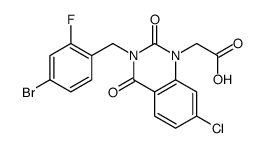112733-06-9
| Name | [3-(4-Bromo-2-fluorobenzyl)-7-chloro-2,4-dioxo-3,4-dihydro-1(2H)- quinazolinyl]acetic acid |
|---|
| Description | Zenarestat is a potent and orally active aldose reductase inhibitor. Zenarestat improves diabetic peripheral neuropathy in Zucker diabetic fatty rats[1]. |
|---|---|
| Related Catalog | |
| In Vivo | Zenarestat (3.2, 32 mg/kg; p.o.; daily for 8 weeks) inhibits nerve sorbitol accumulation in a dose-dependent manner[1]. Animal Model: Zucker diabetic fatty (ZFD) rats (type 2 diabetes models)[1] Dosage: 3.2, 32 mg/kg Administration: P.o.; daily for 8 weeks Result: At 3.2 mg/kg, zenarestat had no significant effect on the delay in F-wave minimal latency (FML) and the slowing of motor nerve conduction velocity (MNCV), although the sorbitol accumulation in the sciatic nerve was partially inhibited in ZDF rats. At 32 mg/kg zenarestat treatment improved these nerve dysfunctions in ZDF rats, along with a reduction of nerve sorbitol accumulation almost to the level of lean rats. |
| References |
| Density | 1.737g/cm3 |
|---|---|
| Boiling Point | 624.4ºC at 760mmHg |
| Molecular Formula | C17H11BrClFN2O4 |
| Molecular Weight | 441.63600 |
| Flash Point | 331.4ºC |
| Exact Mass | 439.95700 |
| PSA | 81.30000 |
| LogP | 2.85110 |
| Vapour Pressure | 1.86E-16mmHg at 25°C |
| Index of Refraction | 1.659 |
